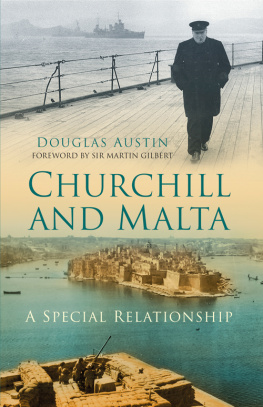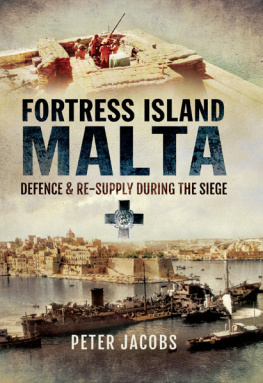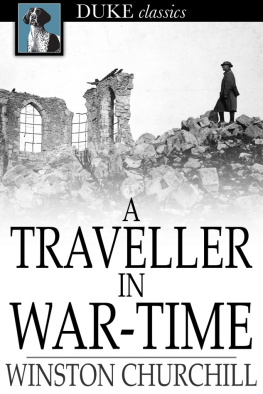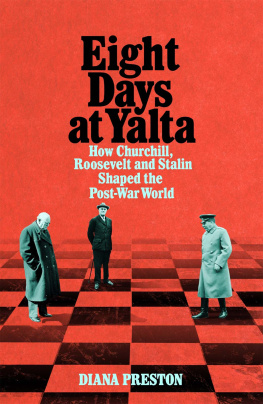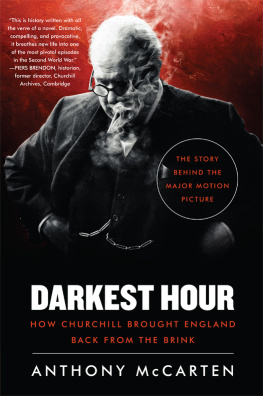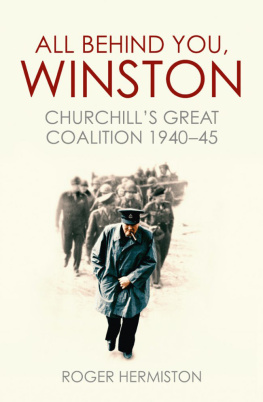

Malta is a little island with a great history. The record of the Maltese people throughout that long history is a record of constancy and fortitude. It is with those qualities, matchlessly displayed, that they are now confronting the dark power of the Axis.
The Right Hon. Winston S. Churchill, C.H., M.P.
Foreword to The Epic of Malta , 1942
My thanks are due first to Sir Martin Gilbert who has kindly written the foreword to this book. The footnotes within will make clear how much I owe to his remarkable scholarship. I also wish to thank Professor David French for his continued support and encouragment. For their help in providing information about the gift to Sir Winston Churchill of the Malta Shield, which still hangs in his study in Chartwell, I am indebted to my good friends Fr. George Aquilina, O.F.M., Mr Michael Refalo, and to Mr Antoine Attard who is the grandson of Antonio Attard who made the Shield. I am also grateful for the help given me by Mr Neil Walters, the National Trust House Manager at Chartwell, not least for making arrangements for me to include a new photograph of the Malta Shield.
Throughout this study numerous quotations have been made from official British government records now lodged at the National Archives at Kew. These documents and the map entitled Malta: Showing airfields in April 1942 (plate section no. 22), which is taken from the Official History, The Mediterranean and Middle East, Vol. III, are Crown Copyright and are reproduced with the permission of the Controller of HMSO and Queens Printer for Scotland.
Numerous quotations have also been included from books, memoranda and letters written by Sir Winston Churchill, some of which form part of the Churchill Papers, which are now held at Churchill College Cambridge. The copyright holder is Winston S. Churchill, administered by Curtis Brown Ltd, and permission to quote from these documents is hereby gratefully acknowledged.
The copyright holders of the photographs included in this volume are as follows and the author is pleased to acknowledge their consent for their use in this volume. Imperial War Museum, London: picture numbers 4, 12-19, 21, 23, 25, 27, 29; Richard Ellis Ltd, Valletta, Malta: 2, 6, 8, 9, 11; Churchill Archive Centre, Broadwater Collection, Winston S. Churchill, administered by Curtis Brown Ltd: 3, 5; Library of Congress: 1, 7, 20, 26, 32; The Times , Malta: 31, 34; National Trust: 30; author: 10, 33, 35-38.
Finally, I wish to acknowledge and pay tribute to the staff and volunteers at Chartwell for the high regard in which they hold the memory of Sir Winston Churchill and the warm welcome they give to the many visitors to Sir Winston and Lady Churchills home.
The author records with great sadness the deaths of Michael A. Refalo in June 2011, and of Fr George Aquilina OFM in Spetember 2012.
Contents
In September 1922 Winston Churchill purchased Chartwell Manor, a house with medieval origins surrounded by 80 acres of land on the greensand hills of Kent near Westerham. It continued to be his principal residence until his death in January 1965, and it was there that he and Mrs. Churchill raised their family. It then reverted by the terms of a previous arrangement to the National Trust and it is now open to the public between April and October each year. On display in the house are many of the thousands of gifts that Sir Winston received during his long life. Among these there hangs in his Study an elaborate silver shield mounted on a black oval base. It is described in the Chartwell Guide Book as A shield bearing the arms of Malta, given by the people of the island. This statement is incorrect in several respects and the author has with the help of Mr. Michael Refalo, Mr. Antoine Attard and Fr. George Aquilina, O.F.M. in Malta, and papers held in the Churchill Archives held at Churchill College Cambridge, pieced together the story of this gift.
In July 1945 the Rt. Hon. Winston Churchill lost the General Election called at the end of the war and became leader of His Majestys Opposition. In May of the following year he received a letter from Lt.-Col. Agius, Trade Commissioner at the Malta Government Office in London, asking if he would be prepared to accept a gift from a Maltese citizen. Lt.-Col. Agius wrote that Mr. Edward Ceravolo wished to present a piece of Maltese silver to Mr. Churchill whom he considers the saviour of the world from slavery and paganism. Churchill said he would be greatly honoured by such a gift.
Edward Ceravolo had lived in Valletta throughout the bombing of 1940-43 and he owned and managed the Splendid bar in Valletta. Although the building is no longer a bar the colourful sign of the Splendid Lounge Bar still hangs on the corner of 34 Archbishop Street. During the Second World War this bar was the haunt of many British and Commonwealth servicemen and Edward Ceravolo named a number of his special drinks after wartime battles. Early in the war he bought two fine examples of Maltese silver that had been made by Antonio Attard, a well-known and highly accomplished silversmith who had had a workshop on St. Pauls Street in Valletta. One was a model of Kingsgate, the old entrance to Valletta. The other was a shield depicting an elaborate and finely crafted array of medieval weapons surrounding a coat of arms. These are not the arms of Malta but rather those of Grand Master Jean Parisot de la Valette. It was he who at the age of 71 had led the resistance of the Knights of St. John and the people of Malta against the Turkish armies of Suleiman the Magnificent in the Great Siege of 1565. Edward Ceravolo had initially thought of presenting the Kingsgate model to Churchill but later decided that the shield would be more appropriate in view of Churchills role during Maltas second Great Siege of 1940-43.
Edward Ceravolo came to England several months later and on Wednesday 24 July 1946 he called on Churchill at his room in the House of Commons, accompanied by Lt.-Col. Agius and Mr. H. A. Bonavia from the Malta Government Office. Edward Ceravolo presented the shield to Churchill saying that it was a token of his admiration of Mr. Churchills leadership of the British nation during the war. He also gave Churchill for Mrs. Churchill, who was not able to be present, a bouquet of red and white rosesMaltas colours. After examining the shield Churchill responded by saying: It is really lovely. I shall keep this in my home and treasure it as a memorial to Maltas great heroism.
Churchill then made arrangements for a signed photograph of himself to be framed in walnut at Aspreys, the London jewellers, and on 4 November he sent this to Edward Ceravolo together with a box of his special Churchill Havana cigars. His covering letter, written at Chartwell, read as follows:
Dear Mr. Ceravolo
I am sending you herewith a photograph which I have signed, and some cigars, as a small measure of recognition of your kindness in presenting me with the beautiful Maltese shield. This, which now hangs in my study here, is a continual source of pleasure to me, and the care and craftsmanship which produced it have my warm admiration. It will also be a perpetual reminder of Maltas gallantry during the war.
Yrs sincerely,
Winston S. Churchill
The shield still hangs today in a place of honour in Churchills Study at Chartwell where he placed it in 1946. The signed photograph, in its walnut frame, that Churchill sent to Edward Ceravolo in November 1946 is now in the care of Fr. Aquilina, O.F.M., Archivist of the Franciscan Order in Valletta to which it was bequeathed by Mr. Ceravolos nephew. The many thousands of visitors who each year pass through Chartwell thus have this valuable and historic reminder of the close ties forged between Winston Churchill and the people of Malta, particularly in the stern days of the Second World War.
Next page
